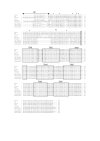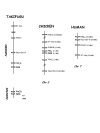Persistence of duplicated PAC1 receptors in the teleost, Sparus auratus
- PMID: 17997850
- PMCID: PMC2245808
- DOI: 10.1186/1471-2148-7-221
Persistence of duplicated PAC1 receptors in the teleost, Sparus auratus
Abstract
Background: : Duplicated genes are common in vertebrate genomes. Their persistence is assumed to be either a consequence of gain of novel function (neofunctionalisation) or partitioning of the function of the ancestral molecule (sub-functionalisation). Surprisingly few studies have evaluated the extent of such modifications despite the numerous duplicated receptor and ligand genes identified in vertebrate genomes to date. In order to study the importance of function in the maintenance of duplicated genes, sea bream (Sparus auratus) PAC1 receptors, sequence homologues of the mammalian receptor specific for PACAP (Pituitary Adenylate Cyclase-Activating Polypeptide), were studied. These receptors belong to family 2 GPCRs and most of their members are duplicated in teleosts although the reason why both persist in the genome is unknown.
Results: : Duplicate sea bream PACAP receptor genes (sbPAC1A and sbPAC1B), members of family 2 GPCRs, were isolated and share 77% amino acid sequence identity. RT-PCR with specific primers for each gene revealed that they have a differential tissue distribution which overlaps with the distribution of the single mammalian receptor. Furthermore, in common with mammals, the teleost genes undergo alternative splicing and a PAC1Ahop1 isoform has been characterised. Duplicated orthologous receptors have also been identified in other teleost genomes and their distribution profile suggests that function may be species specific. Functional analysis of the paralogue sbPAC1s in Cos7 cells revealed that they are strongly stimulated in the presence of mammalian PACAP27 and PACAP38 and far less with VIP (Vasoactive Intestinal Peptide). The sbPAC1 receptors are equally stimulated (LOGEC50 values for maximal cAMP production) in the presence of PACAP27 (-8.74 +/- 0.29 M and -9.15 +/- 0.21 M, respectively for sbPAC1A and sbPAC1B, P > 0.05) and PACAP38 (-8.54 +/- 0.18 M and -8.92 +/- 0.24 M, respectively for sbPAC1A and sbPAC1B, P > 0.05). Human VIP was found to stimulate sbPAC1A (-7.23 +/- 0.20 M) more strongly than sbPAC1B (-6.57 +/- 0.14 M, P < 0.05) and human secretin (SCT), which has not so far been identified in fish genomes, caused negligible stimulation of both receptors.
Conclusion: : The existence of functionally divergent duplicate sbPAC1 receptors is in line with previously proposed theories about the origin and maintenance of duplicated genes. Sea bream PAC1 duplicate receptors resemble the typical mammalian PAC1, and PACAP peptides were found to be more effective than VIP in stimulating cAMP production, although sbPAC1A was more responsive for VIP than sbPAC1B. These results together with the highly divergent pattern of tissue distribution suggest that a process involving neofunctionalisation occurred after receptor duplication within the fish lineage and probably accounts for their persistence in the genome. The characterisation of further duplicated receptors and their ligands should provide insights into the evolution and function of novel protein-protein interactions associated with the vertebrate radiation.
Figures







Similar articles
-
Hypophysiotropic action of pituitary adenylate cyclase-activating polypeptide (PACAP) in the goldfish: immunohistochemical demonstration of PACAP in the pituitary, PACAP stimulation of growth hormone release from pituitary cells, and molecular cloning of pituitary type I PACAP receptor.Endocrinology. 1998 Aug;139(8):3465-79. doi: 10.1210/endo.139.8.6145. Endocrinology. 1998. PMID: 9681497
-
A cloned frog vasoactive intestinal polypeptide/pituitary adenylate cyclase-activating polypeptide receptor exhibits pharmacological and tissue distribution characteristics of both VPAC1 and VPAC2 receptors in mammals.Endocrinology. 1999 Mar;140(3):1285-93. doi: 10.1210/endo.140.3.6576. Endocrinology. 1999. PMID: 10067855
-
Pituitary adenylate cyclase-activating polypeptide (PACAP) and PACAP-receptor type 1 expression in rat and human placenta.Endocrinology. 2000 Mar;141(3):1158-67. doi: 10.1210/endo.141.3.7346. Endocrinology. 2000. PMID: 10698193
-
[Pituitary adenylate cyclase-activating polypeptide].Ann Endocrinol (Paris). 1998 Dec;59(5):364-405. Ann Endocrinol (Paris). 1998. PMID: 9949891 Review. French.
-
[Physiological significance of pituitary adenylate cyclase-activating polypeptide (PACAP) in the nervous system].Yakugaku Zasshi. 2002 Dec;122(12):1109-21. doi: 10.1248/yakushi.122.1109. Yakugaku Zasshi. 2002. PMID: 12510388 Review. Japanese.
Cited by
-
Alternative Splicing of the Pituitary Adenylate Cyclase-Activating Polypeptide Receptor PAC1: Mechanisms of Fine Tuning of Brain Activity.Front Endocrinol (Lausanne). 2013 May 21;4:55. doi: 10.3389/fendo.2013.00055. eCollection 2013. Front Endocrinol (Lausanne). 2013. PMID: 23734144 Free PMC article.
-
An independent genome duplication inferred from Hox paralogs in the American paddlefish--a representative basal ray-finned fish and important comparative reference.Genome Biol Evol. 2012;4(9):937-53. doi: 10.1093/gbe/evs067. Epub 2012 Jul 31. Genome Biol Evol. 2012. PMID: 22851613 Free PMC article.
-
Insights into shell deposition in the Antarctic bivalve Laternula elliptica: gene discovery in the mantle transcriptome using 454 pyrosequencing.BMC Genomics. 2010 Jun 8;11:362. doi: 10.1186/1471-2164-11-362. BMC Genomics. 2010. PMID: 20529341 Free PMC article.
-
The serendipitous origin of chordate secretin peptide family members.BMC Evol Biol. 2010 May 6;10:135. doi: 10.1186/1471-2148-10-135. BMC Evol Biol. 2010. PMID: 20459630 Free PMC article.
-
Same same, but different: exploring the enigmatic role of the pituitary adenylate cyclase-activating polypeptide (PACAP) in invertebrate physiology.J Comp Physiol A Neuroethol Sens Neural Behav Physiol. 2024 Nov;210(6):909-925. doi: 10.1007/s00359-024-01706-5. Epub 2024 Jun 28. J Comp Physiol A Neuroethol Sens Neural Behav Physiol. 2024. PMID: 38940930 Free PMC article.
References
-
- Ohno S. Evolution by gene duplication. Berlin, New York, Springer-Verlag; 1970.
-
- Iwabe N, Kuma K, Miyata T. Evolution of gene families and relationship with organismal evolution: rapid divergence of tissue-specific genes in the early evolution of chordates. Mol Biol Evol. 1996;13:483–493. - PubMed
Publication types
MeSH terms
Substances
Grants and funding
LinkOut - more resources
Full Text Sources

